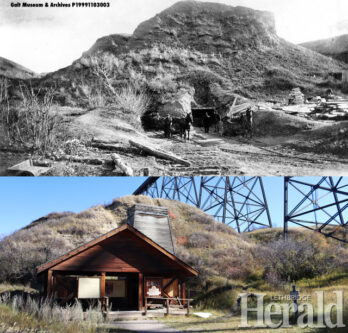Coal dust in our veins: Miners began work at what would become Lethbridge exactly 140 years ago
By Alejandra Pulido-Guzman - Lethbridge Herald on October 14, 2022.
 Miners stand at the entrances of the North Western Coal & Navigation Company's Drift Mines 1 and 2 in the riverbottom in the 1880s - Galt Museum & Archives 19991103003 - and
The Coalbanks Kiosk marks the site as it looks today. Herald photo by Alejandra Pulido-Guzman
Miners stand at the entrances of the North Western Coal & Navigation Company's Drift Mines 1 and 2 in the riverbottom in the 1880s - Galt Museum & Archives 19991103003 - and
The Coalbanks Kiosk marks the site as it looks today. Herald photo by Alejandra Pulido-GuzmanLETHBRIDGE HERALDapulido@lethbridgeherald.com
The early beginnings of what we now call the City of Lethbridge can be traced back to the first North Western Coal and Navigation mine started on Oct. 13, 1882.
Lethbridge Historical Society president, Belinda Crowson, said that deciding where that mine would go was actually the decision that set in motion where the City of Lethbridge would be located today.
“When they (the company) sent people out – William Stafford, Captain Bryant and a few others – to check on coal, they checked here along what is now the Oldman River, which was the Belly River in those days, they checked along the Bow River and other places, but this is the location where they decided there was the best coal,” said Crowson.
She said it was by that decision and the start of that mine, that the development of the community that is now Lethbridge began.
“The supervisor at that time was William Stafford and he was the one who sort of had a say in where the mine would be built, and they started digging into the coulee on the 13th of October 1882 and started to take coal out of the mine in December of that year,” said Crowson. Â
She said it was a very small operation with about 15 miners that had come with Stafford from Nova Scotia, and when the miners first came to the area, they were building the community themselves.
“This is really where you see the beginning and eventually a little community will start in the river valley which had the name Coalbanks,” said Crowson.
She said the early miners lived in dugouts. They dug a hole on the side of the coulee and lined it with lumber and lived there until homes were built.
“We know that the Perry family and a few others did, but then the other thing is they would cut down the trees in the river valley and made houses as quickly as possible,” said Crowson.
According to a display in the old coal mine, located in the river bottom, the company town of Coalbanks began, flourished and faded in three short years.
It began as the North Western Coal and Navigation Company Limited miners’ camp, when William Stafford and 15 Nova Scotia miners arrived to open the first drift mines at the coal banks.
“Next issue was how to transport it, that’s when the next year they started to build the barges to move the coal to Medicine Hat where the CPR had brought the train,” said Crowson.
The display also shows that the company quickly established all of the facilities needed for the mining operation by the end of 1883 and a dock was built into the Oldman River for barges used to ship coal to the CPR mainline.
The display also shows that the company built homes for the miners and their families. A large home called Coaldale was built for Elliott Galt the general manager, a slightly smaller home was built for William Stafford. Stafford’s wife and their nine children were among the first families to settle at Coalbanks. For the minors without families the company built boarding houses, bunkhouses, and shacks which were rented at reasonable rates.
By 1884 the population of Coalbanks peaked at about 250, on Oct. 31 of that year, the first European baby, Henrietta Galt Lethbridge Stafford was born in the community.
“For the first three years or so most of the community was only in the river valley. It’s when the train arrived in 1885 that we see the community move from the river valley to the Prairie level, officially named Lethbridge and grow very quickly at that point,” said Crowson.
In May 1885 a new townsite was laid out and the town was initially named Coalbanks as an expansion of the river valley community, but its citizens preferred the name Lethbridge after William Lethbridge who was the first president of the company. In October 1885 the new community was officially named Lethbridge and by the end of 1885 it had a population of over 1000.
In 1891 Lethbridge was incorporated as a municipality as the Town of Lethbridge and in that year the first elections were held and Charles Magrath was elected to be the first mayor.
Follow @APulidoHerald on Twitter
21-20


